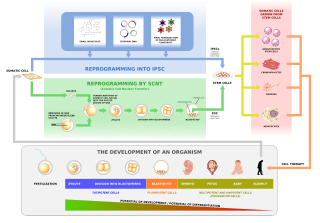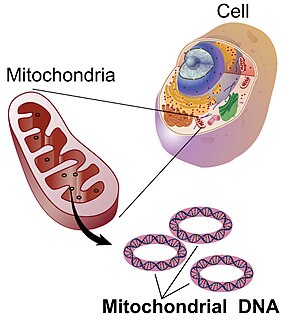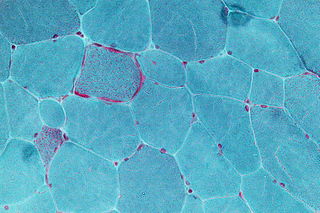Related Research Articles

Cloning is the process of producing individuals with identical or virtually identical DNA, either naturally or artificially. In nature, many organisms produce clones through asexual reproduction. Cloning in biotechnology refers to the process of creating clones of organisms or copies of cells or DNA fragments.

Human cloning is the creation of a genetically identical copy of a human. The term is generally used to refer to artificial human cloning, which is the reproduction of human cells and tissue. It does not refer to the natural conception and delivery of identical twins. The possibility of person cloning has raised controversies. These ethical concerns have prompted several nations to pass laws regarding human cloning and its legality.

A zygote is a eukaryotic cell formed by a fertilization event between two gametes. The zygote's genome is a combination of the DNA in each gamete, and contains all of the genetic information necessary to form a new individual. In multicellular organisms, the zygote is the earliest developmental stage. In single-celled organisms, the zygote can divide asexually by mitosis to produce identical offspring.

Mitochondrial DNA is the DNA located in mitochondria, cellular organelles within eukaryotic cells that convert chemical energy from food into a form that cells can use, adenosine triphosphate (ATP). Mitochondrial DNA is only a small portion of the DNA in a eukaryotic cell; most of the DNA can be found in the cell nucleus and, in plants and algae, also in plastids such as chloroplasts.

A genetic chimerism or chimera is a single organism composed of cells with more than one distinct genotype. In animals, this means an individual derived from two or more zygotes, which can include possessing blood cells of different blood types, subtle variations in form (phenotype) and, if the zygotes were of differing sexes, then even the possession of both female and male sex organs. Animal chimeras are produced by the merger of multiple fertilized eggs. In plant chimeras, however, the distinct types of tissue may originate from the same zygote, and the difference is often due to mutation during ordinary cell division. Normally, genetic chimerism is not visible on casual inspection; however, it has been detected in the course of proving parentage.

Mitochondrial disease is a group of disorders caused by mitochondrial dysfunction. Mitochondria are the organelles that generate energy for the cell and are found in every cell of the human body except red blood cells. They convert the energy of food molecules into the ATP that powers most cell functions.

Embryology is the branch of biology that studies the prenatal development of gametes, fertilization, and development of embryos and fetuses. Additionally, embryology encompasses the study of congenital disorders that occur before birth, known as teratology.

In genetics and developmental biology, somatic cell nuclear transfer (SCNT) is a laboratory strategy for creating a viable embryo from a body cell and an egg cell. The technique consists of taking an enucleated oocyte and implanting a donor nucleus from a somatic (body) cell. It is used in both therapeutic and reproductive cloning. In 1996, Dolly the sheep became famous for being the first successful case of the reproductive cloning of a mammal. In January 2018, a team of scientists in Shanghai announced the successful cloning of two female crab-eating macaques from fetal nuclei.
A somatic cell, or vegetal cell, is any biological cell forming the body of an organism; that is, in a multicellular organism, any cell other than a gamete, germ cell, gametocyte or undifferentiated stem cell.

The Human Fertilisation and Embryology Authority (HFEA) is an executive non-departmental public body of the Department of Health and Social Care in the United Kingdom. It is a statutory body that regulates and inspects all clinics in the United Kingdom providing in vitro fertilisation (IVF), artificial insemination and the storage of human eggs, sperm or embryos. It also regulates human embryo research.

A designer baby is a baby whose genetic makeup has been selected or altered, often to include a particular gene or to remove genes associated with a disease. This process usually involves analysing a wide range of human embryos to identify genes associated with particular diseases and characteristics, and selecting embryos that have the desired genetic makeup; a process known as preimplantation genetic diagnosis. Other potential methods by which a baby's genetic information can be altered involve directly editing the genome before birth. This process is not routinely performed and only one instance of this is known to have occurred as of 2019, where Chinese twins Lulu and Nana were edited as embryos, causing widespread criticism.

Miodrag Stojković is a Serbian researcher in genetics with the Institute of Human Genetics at Newcastle University. He holds a PhD from the Ludwig-Maximilians University in Munich. As of January 2006, he is serving as a Deputy Director and Head of Cellular Reprogramming Laboratory, Centro de Investigación Príncipe Felipe, Valencia, Spain.

The Human Fertilisation and Embryology Act 1990 is an Act of the Parliament of the United Kingdom. It created the Human Fertilisation and Embryology Authority which is in charge of human embryo research, along with monitoring and licensing fertility clinics in the United Kingdom.
Stem cell laws are the law rules, and policy governance concerning the sources, research, and uses in treatment of stem cells in humans. These laws have been the source of much controversy and vary significantly by country. In the European Union, stem cell research using the human embryo is permitted in Sweden, Spain, Finland, Belgium, Greece, Britain, Denmark and the Netherlands; however, it is illegal in Canada, Germany, Austria, Ireland, Italy, and Portugal. The issue has similarly divided the United States, with several states enforcing a complete ban and others giving support. Elsewhere, Japan, India, Iran, Israel, South Korea, China, and Australia are supportive. However, New Zealand, most of Africa, and most of South America are restrictive.

The Human Fertilisation and Embryology Act 2008 is an Act of the Parliament of the United Kingdom. The Act constitutes a major review and update of the Human Fertilisation and Embryology Act 1990.
Mitochondrial replacement therapy is the replacement of mitochondria in one or more cells to prevent or ameliorate disease. MRT originated as a special form of in vitro fertilisation in which some or all of the future baby's mitochondrial DNA comes from a third party. This technique is used in cases when mothers carry genes for mitochondrial diseases. The therapy is approved for use in the United Kingdom. A second application is to use autologous mitochondria to replace mitochondria in damaged tissue to restore the tissue to a functional state. This has been used in clinical research in the United States to treat cardiac-compromised newborns.

The Human Reproductive Cloning Act 2001 is an Act of the Parliament of the United Kingdom "to prohibit the placing in a woman of a human embryo which has been created otherwise than by fertilisation". The act received Royal Assent on 4 December 2001.

Gábor Vajta is a medical doctor, human pathologist and mammalian embryologist living in Cairns, Queensland, Australia. Vajta is an Honorary Professor of the BGI College, Shenzhen, China, and Adjuct Professor of the Central Queensland University, Rockhampton, Queensland, Australia. After an early career in human pathology he turned to embryology in 1989 and obtained a Doctor of Science degree in Domestic Animal Embryology at the Royal Veterinary and Agricultural University in Copenhagen, Denmark in 1999. During the past 25 years he has co-developed several patents relating to embryology, most notably the method of Handmade Cloning (HMC), the Submarine Incubation System (SIS), the Open Pulled Straw (OPS) vitrification and the Well of the Well (WOW) system. Currently Professor Vajta is director of a consulting company providing services in human and domestic animal embryology all over the world.
Shoukhrat Mitalipov is an American biologist who heads the Center for Embryonic Cell and Gene Therapy at the Oregon Health & Science University in Portland. He is a well known pioneer of many nuclear transplantation studies and was named in 2013 by journal Nature as "the cloning chief". Mitalipov is also a godfather of a gene therapy, known as mitochondrial replacement therapy, that prevents inheritance of mitochondrial diseases. He discovered a new way of creating human stem cells from skin cells.
The terms human–animal hybrid and animal–human hybrid refer to an entity that incorporates elements from both humans and animals.
References
- ↑ "Human Fertilisation and Embryology Act 2008 : Department of Health". Department of Health (United Kingdom). 1 September 2009. Retrieved 11 December 2009.